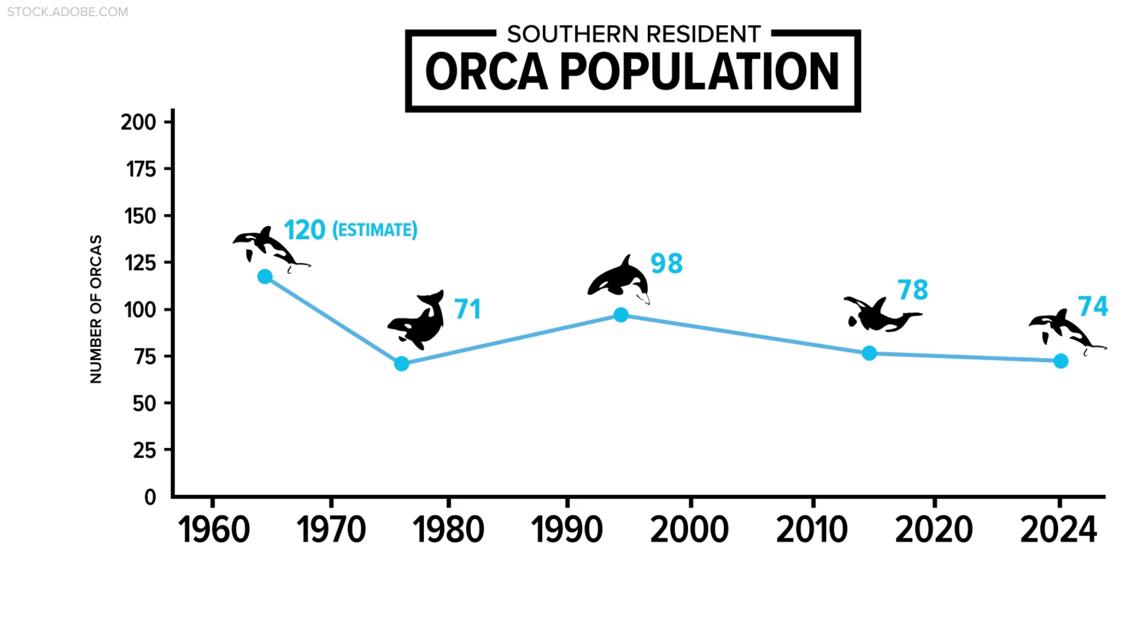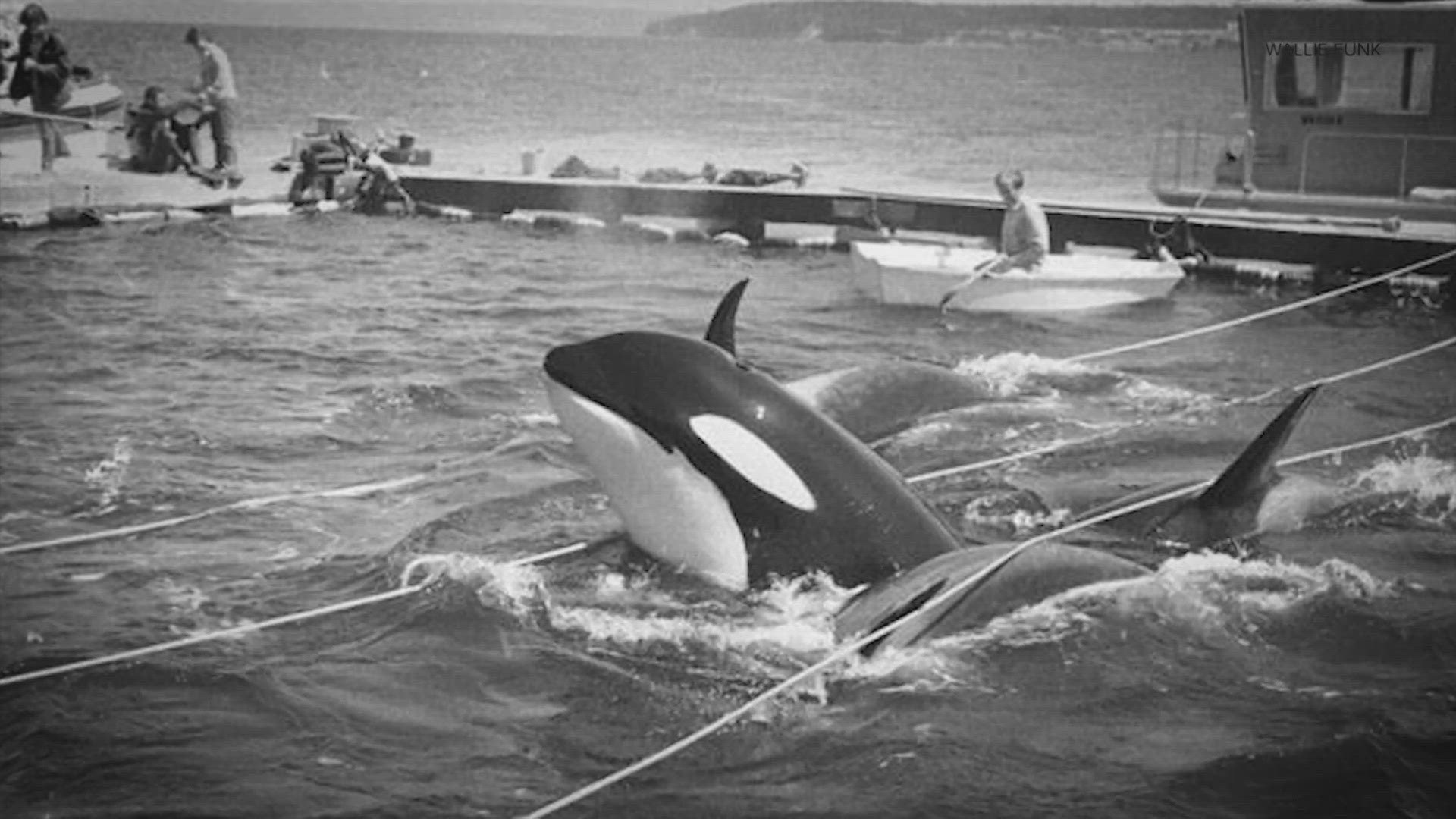SEATTLE — An orca species unique to the Northwest and closely connected to indigenous populations is struggling to survive.
The Southern Resident Killer Whales, or SRKW, currently have a population of 74 whales -- a number expected to drop by one in the upcoming census, according to the Orca Conservancy.
Southern Residents have struggled due to the loss of Chinook salmon population and pollutants in the waters they call home, but whale rounds-up of the 60s and 70s were the first issue to have a negative impact on the population.
Local tribes consider the Southern Resident orcas family, Raynell Morris said, and are impacted by the same issues the resident orcas face.
"They're starving for salmon. We're starving for salmon. They're unhealthy because of the water. We're unhealthy because of the water," Morris said. “And now we're at an all-time point of extinction for them as a population, as a people, as our relatives."
The Lummi tribal elder uses a spot at Cherry Point Beach overlooking the Strait of Georgia to pray and connect with her ancestors. Directly behind the beach is an ancient burial spot of the Lummi people. However, the prayers here include non-human relatives too.
"We love you. We know you're starving. We hear you," Morris repeated.
The start of the Southern Residents' decline
The SRKW is made up of three families. The J, K and L pods. L pod is the largest family with 34 orcas today. J pod includes 25 and K pod has just 15.
The decline in numbers began in the 1960s as Southern Residents were picked out of the waters of Puget Sound. Some of the first organized captures were led by Ted Griffin and his team from the Seattle Public Aquarium.
"It was completely legal. Permits were issued," said Michael Weiss, a research director for the Center for Whale Research.
Capturers corralled the orcas with speed boats and even used bombs. They ensnared some in nets.
From the 1960s to mid-1970s, hundreds of whales were captured in Washington and British Columbia waters.
"Southern Residents in terms of number of whales and impact on population were really hit the hardest," Weiss said.
At least 11 died during captures and 36 were taken into captivity at marine parks. Specifically young orcas were targeted, including Tokitae. By 1987, known as Lolita at the Miami Seaquarium, she was the sole survivor of the orcas captured in Puget Sound. She died in 2023.
“Those captures were targeted. Not random. It’s not that a third of the population is randomly removed. It’s a generation of killer whales is removed," Weiss said.
That means today, the Southern Residents are missing post reproductive females over the age or 40 or 50. With that loss comes a lack of knowledge of how to find food and catch, especially when there aren't a lot of fish around.
Missing that generation of grandmothers could have a huge impact, Weiss said.
Tracking the population
Canadian Dr. Michael Bigg was the first to photo-identify wild whales population size and family structure, according to whale researchers. Bigg started the practice in the 1970s to get a more accurate account of killer whale populations.
“At the time the wisdom was there were hundreds and hundreds of killer whales, because they were seeing them all the time," Weiss said. "We started to realize there’s not hundreds of hundreds of whales. We're seeing them over and over again.”
Weiss’ team at the Center for Whale Research started tracking the Southern Resident population in 1976.
At the time, 71 orcas remained. Researchers estimate there may have been 100-120 before the captures began.
"It really took a Washington state level bit of legislation to say there would be no more killer whale captures in the state," Weiss said.
Slowly the Southern Resident population rebounded to 98 by 1994.
Scientists believe that happened over a period of time the orcas' food supply -- 80% of which is Chinook salmon -- was plentiful.


An endangered species
However, Chinook stock has declined for decades and the salmon were classified as endangered in 1994. Some populations have decreased by as much as 90% since the early 20th century.
Weiss said a degradation of spawning rivers, increase in ocean temperatures and pollutants have all negatively impacted Chinook populations.
"When there's more Chinook, the whales survive better. It's really that simple," said Weiss.
So it's not surprising that the Southern Residents received the 'endangered' designation in 2005. That categorization protects the orcas in part by putting policies in place to encourage conservationism.
"So, you've got one endangered species relying on another endangered species to survive," Weiss said.
Many organizations have joined Morris and the Lummi nation in trying to save the Northwest’s beloved whales.
"We don't have anymore time. It's now. It's that urgent. It's that critical. It has to happen now," Morris said.
It's urgent because other human-caused factors are preventing the Southern Residents from thriving today. Tuesday on KING 5, the Environment Northwest team explores the impact of pollutants and other health challenges for Southern Residents.

